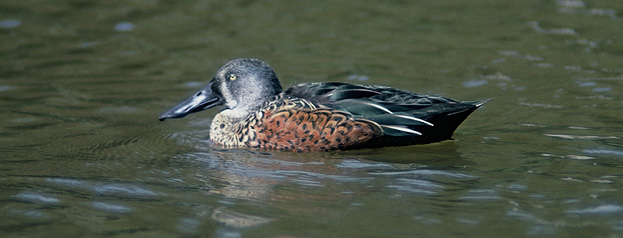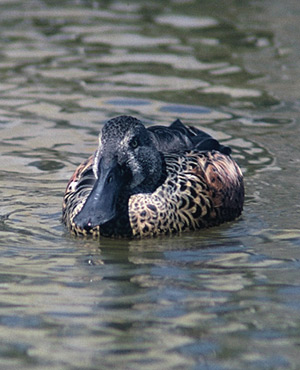|
|
| |
 |
| |
Home > New Zealand ecology > Native ducks > New Zealand shoveler |
| |
| |
 |
| |
|
|
| |
| |
The New Zealand shoveler Anas rhynchotis variegata, also known as kuruwhengi, is a subspecies endemic to New Zealand. It belongs to the Anatidae family and Anseriformes order of swans, geese and ducks.
The male shoveler is New Zealand's most handsome duck, with variegated plumage, blue-grey head with a white vertical stripe between the eye and bill, a striking reddish-brown breast, and blue wings. Nature has lavished more beauty on the male than the less attractive female. |
| |
 |
| |
Above: New Zealand shoveler Anas rhynchotis variegata
Photo J.L. Kendrick, Crown Copyright © Department of Conservation.
 View slideshow of larger images View slideshow of larger images |
| |
 |
| |
The female is more plainly embellished with cryptic brown similar to female mallards and grey ducks. This may be nature's way of providing camouflage when she is nesting.
As a migrant from Australia, the New Zealand shoveler is a subspecies of the Australasian shoveler A. rhynchotis which occupies a large range. The first New Zealand specimens were collected by P. Earl in Waikouaiti in the South Island, and Dieffenbach in the Chatham Islands around 1840.
The other subspecies, the Australasian shoveler Anas rhynchotis rhynchotis, occurs in the southeastern and southwestern regions of mainland Australia, and in Tasmania. |
| |
 |
| |
|
|
| |
 |
| |
Above: A male New Zealand shoveler Anas rhynchotis variegata at the National Wildlife Centre, Mt Bruce, 1971. Photo J.L. Kendrick, Crown Copyright © Department of Conservation.
 View larger images View larger images |
| |
 |
| |
The species Australasian shoveler Anas rhynchotis does not approach the threshold of population size, so it is listed as 'least concern' in the 2009 IUCN Red List of Threatened Species.
The subspecies New Zealand shoveler Anas rhynchotis variegata is listed as 'not threatened' in the New Zealand Threat Classification System.
It also occupies tidal harbours, and since becoming the first duck to be acutely aware of hunting, it quickly goes to the open ocean when the shooting begins. Shovelers are the fastest flyers of all waterfowl, so their swift flight at the first sound of a shotgun helps their survival.
Unlike other indigenous dabbling ducks that have adapted to pasture, the New Zealand shoveler is unable to supplement its diet by grazing on grass. |
| |
 |
| |
Shovelers are the fastest flyers of all waterfowl, so their swift flight helps survival when hunting begins. |
| |
 |
| |
Shovelers swim with their bill submerged, sieving food from the water surface, and even through mud. The peculiar broad bill is predominant as soon as the chick is hatched.
The shoveler's sifting apparatus is very well developed with fine growths called lamellae on the edges of it's large wedge shaped bill, and bristles on its' tongue that sieve soft food.
Their food is mainly freshwater invertebrates and the seeds of aquatic plants, however, worms and insects are sometimes eaten in flooded pasture. The population is constantly threatened by the drainage of their preferred wetland habitat of fertile raupo edged shallows.
During a period of winter courting in July and August, flocks with as many as 1,000 ducks gather on lakes, before going off to claim their breeding territory.
Grass nests on the ground close to the waters edge are lined with down, and well covered in thick vegetation which is most often raupo.
Six to ten cream-coloured eggs with a blue tint are laid between August and December. The female is the sole incubator for 26 days. Shovelers are 48 cm long. The male weighs 650 grammes and the female weighs 600 grammes. |
| |
 |
| |
 |
|
|
One of three unprotected native ducks that is still hunted .....
The New Zealand shoveler is one of the few native birds that is not protected, with about 30,000 birds needlessly shot during the duck hunting season each year.
The population was about 150,000 birds in 1980. It is found in lowland swamps and lake edges throughout the country, except Stewart Island where it is uncommon.
| |
 |
| |
The New Zealand shoveler is one of the few native birds that is not protected, with about 30,000 shot during duck hunting season. |
| |
 |
| |
According to the Wildlife Act 1953, the New Zealand shoveler is "wildlife declared to be game".
In the North Canterbury Game Region during the 2010/2011 season, Fish & Game New Zealand have a shoveler daily bag limit of two per hunter during a 30-day season.
The daily bag limit is normally two birds in all game regions except Northland where it is three, and Waikato where it is one. The season varies from one to two months, except Southland which is three months.
Other native waterfowl that are hunted include nationally critical grey duck Anas superciliosa superciliosa, and non-threatened paradise shelduck Tadorna variegata, and pukeko Porphyrio melanotus.
Six protected native ducks include four Anas species of teal, New Zealand scaup Aythya novaeseelandiae, and blue duck Hymenolaimus malachorhynchos.
|
|


